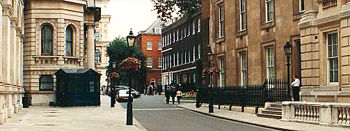Downing Street

Downing Street is the street in London, England, which for over two hundred years has contained the official residences of two of the most senior British cabinet ministers: the First Lord of the Treasury, an office held by the Prime Minister of the United Kingdom, and the Second Lord of the Treasury, an office held by the Chancellor of the Exchequer. The most famous address in Downing Street is 10 Downing Street, the official residence of the First Lord of the Treasury—and thus, in modern times, the residence of the Prime Minister, since the two roles have usually been filled by the same person (exclusively so since 1902). As a result of this, Downing Street or Number 10 is often used as a metonym for the Prime Minister or his or her office, while Number 11 is likewise a term for the Chancellor of the Exchequer or his or her office.
Downing Street is located in Whitehall in central London, a few minutes' walk from the Houses of Parliament and a little further from Buckingham Palace. The street was built in the 1680s by Sir George Downing, 1st Baronet (1632–1689) on the site of a mansion called Hampden House. Downing was a soldier and diplomat who served under Oliver Cromwell and King Charles II. In the service of the King he was rewarded with the plot of land adjoining St James's Park upon which Downing Street now stands. The Prime Minister, the Chancellor of the Exchequer, and the Chief Whip all officially live in houses on one side of the street. The houses on the other side were all replaced by the Foreign Office in the nineteenth century. In the 1950s and 1960s, plans were considered to demolish both the Foreign Office and the rest of Downing Street and build "something more modern". However, these plans were never implemented and have long since been abandoned.
Contents |
Houses in Downing Street

9 Downing Street was named in 2001 and is the Downing Street entrance to the Privy Council Office and currently houses the Chief Whip's office. It was formerly part of Number 10.
10 Downing Street is the official residence of the First Lord of the Treasury, and thus the residence of the British Prime Minister, as in modern times, the two roles have been filled by the same person.
11 Downing Street is the home of the Second Lord of the Treasury, and thus the Chancellor of the Exchequer.
12 Downing Street, formerly the Chief Whip's Office, currently houses the Prime Minister's Press Office, Strategic Communications Unit and Information and Research Unit.
14 Downing Street formerly closed off the western end of the street. It was acquired by the Crown in 1798, and was used by the Colonial Office in the 19th century. Some parts were demolished in the 1860s, and by 1876 it had been removed completely.
Throughout the history of these houses, ministers have lived by agreement in whatever rooms they thought necessary. On some occasions Number 11 has been occupied not by the Chancellor of the Exchequer but by the individual considered to be the nominal deputy Prime Minister (whether or not they actually took the title); this was particularly common in coalition governments. Sometimes a minister will only use their Downing Street flat for formal occasions and otherwise live elsewhere.
During his last period in office, in 1881, William Gladstone claimed residence in numbers 10, 11 and 12 for himself and his family. This was reasonable since he was both Chancellor of the Exchequer and Prime Minister at the time.

After the 1997 General Election, in which Labour took power, a swap was carried out by the then-incumbents of the two titles, Tony Blair being a married man with three children still living at home, while his counterpart, Gordon Brown, was unmarried at the time of taking up his post. Although Number 10 continued to be the Prime Minister's official residence and contain the prime ministerial offices, Blair and his family actually moved into the more spacious Number 11, while Brown lived in the more meagre apartments of Number 10. This is the second time this has occurred; Stafford Northcote lived in Number 10 at one point, while Prime Minister Benjamin Disraeli occupied Number 11. Interestingly, this event was for precisely the opposite reason—at the time, Number 10 was the more spacious apartment and Sir Stafford had a larger family.
Downing Street gates
In the early 20th century as the movement for Irish independence increased in violence, three-metre-high wooden barricades were erected at the end of the street. [1] The barriers were taken down in 1922 with the creation of the Irish Free State, but returned in 1989 in the form of, large, black, steel gates. Again this was due to an increase in violence, particularly by the Provisional IRA.

Security
Since 1989 entering Downing Street has required passing through a security checkpoint. The street is patrolled by armed police, and there is always at least one police officer outside the door of Number 10.
See also
- List of eponymous roads in London
References
- ↑ "Number 10 Transformed". UK Government.
External links
- Downing Street at the Survey of London online (see items 14-18 in the table of contents).